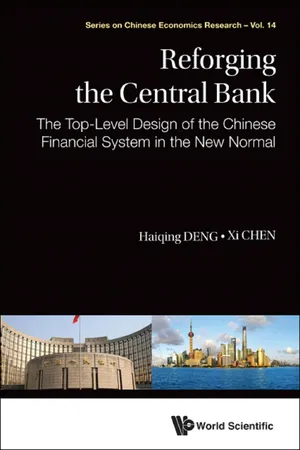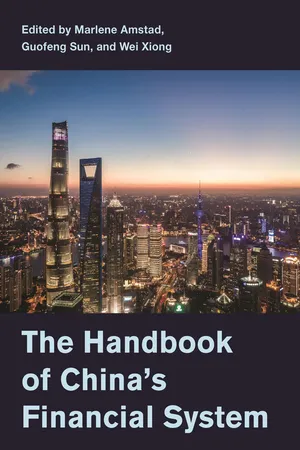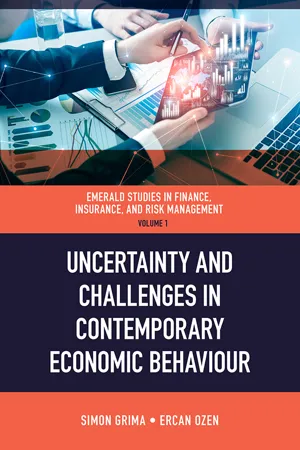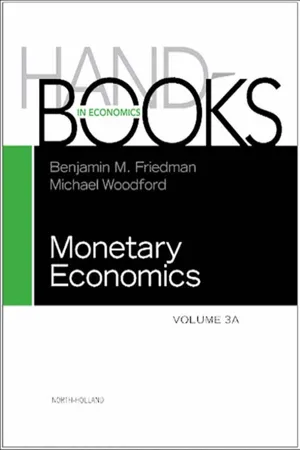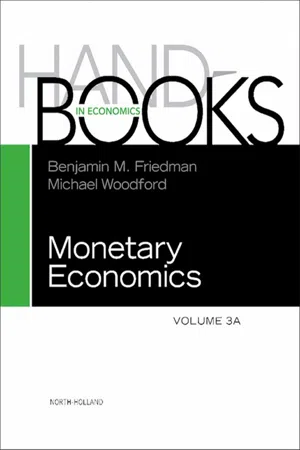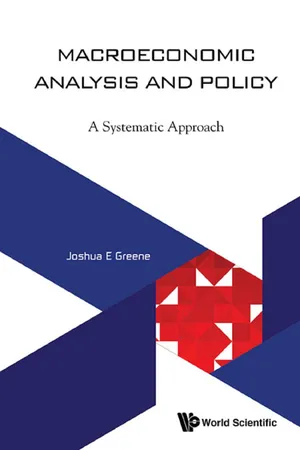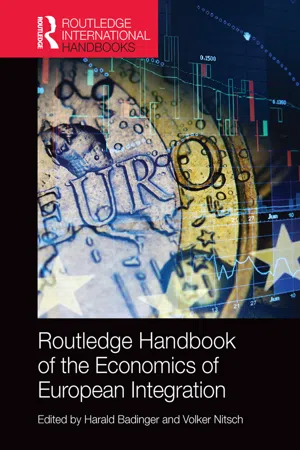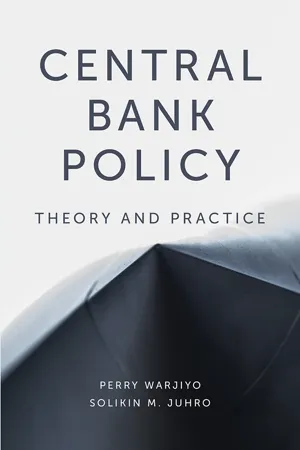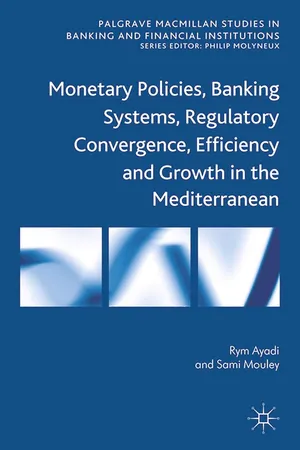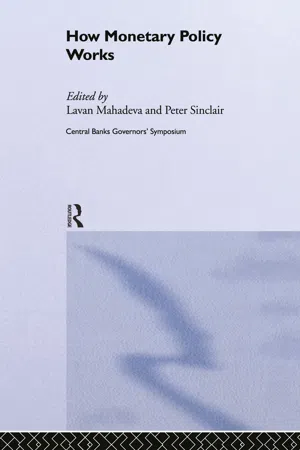Economics
Monetary Transmission Mechanism
The monetary transmission mechanism refers to the process through which changes in monetary policy, such as interest rate adjustments by central banks, impact the broader economy. This mechanism involves the transmission of these policy changes through financial markets, affecting borrowing costs, investment decisions, consumer spending, and ultimately influencing economic activity and inflation.
Written by Perlego with AI-assistance
Related key terms
11 Key excerpts on "Monetary Transmission Mechanism"
- eBook - ePub
Reforging The Central Bank: The Top-level Design Of The Chinese Financial System In The New Normal
The Top-Level Design of the Chinese Financial System in the New Normal
- Haiqing Deng, Xi Chen(Authors)
- 2016(Publication Date)
- WSPC(Publisher)
Chapter SixNew Transmission Mechanism for Monetary Policy
Monetary policy transmission mechanism refers to the process where monetary policies are realized with monetary policy tools. Research on the transmission mechanism focuses on interest rate channel, asset price channel, credit channel, etc. However, these channels do not represent the whole monetary policy transmission mechanism but form one of the many parts of the mechanism — how activities in the financial market (including interest rate, exchange rate, stock price, credit, etc.) impact the real economy. Nevertheless, researches on how central bank’s monetary policies transmit into the financial market are scarce.In the New Normal, China will build a “central bank → money market (benchmark interest rate) → financial market → real economy” transmission mechanism. In this mechanism, the process of “central bank → money market (benchmark interest rate)” mainly relies on short- to medium-term monetary tools such as open market operations and MLF; “money market (benchmark interest rate) → financial market” refers to the transmission from the money market to other markets; “financial market → real economy” stands for the traditionally defined monetary policy transmission channels. - eBook - ePub
- Marlene Amstad, Guofeng Sun, Wei Xiong(Authors)
- 2020(Publication Date)
- Princeton University Press(Publisher)
4. THE TRANSMISSION MECHANISMS OF CHINA’S MONETARY POLICYSo the PBC has all the key components of a monetary policy framework—policy objectives, intermediate targets, and policy instruments. But can China’s monetary policy work properly? Answers to this question boil down to the effectiveness of the policy transmission mechanism. This mechanism of the monetary policy concerns how policy actions affect the policy targets:Policy instruments → operational targets → intermediate targets → ultimate goalsAlternatively, the transmission mechanism may also be viewed as follows:Central bank → financial institutions/financial markets → enterprises/households → national income/national priceAfter the central bank adjusts the policy instruments, monetary aggregates and interest rates change accordingly. These affect the lending activities of commercial banks and conditions of financial markets. These are then transmitted to the real economy, such as investment and consumption, which in turn determine price and output of the whole economy. In any case, the effectiveness of the transmission mechanism of monetary policy depends on proper functioning of both the financial and the real sectors. Failure in any segment of the above process will weaken the efficiency of monetary policy transmission.4.1. Possible Transmission ChannelsThe literature has specified several possible channels for transmission of the monetary policy. According to the overview given by Mishkin (1996), there exist not only a traditional interest rate channel, but also asset price channels and credit channels. Additionally, there also exists an “expectations channel,” which emphasizes the central bank’s ability to influence expectations of economic agents and thus to affect economic outcomes through its communication with the market (Evans et al., 2001; Woodford, 2005; Geraats, 2009). Based on chart from Kuttner and Mosser (2002), figure 2.9 - eBook - ePub
- D. Chorafas(Author)
- 2013(Publication Date)
- Palgrave Macmillan(Publisher)
5 Preserving the Value of Money 1. Transmission Mechanism of Monetary PolicyTo work as intended, monetary policy (chapter 3 ) needs an effective transmission mechanism that is both efficient and well-understood by those who use it. It must as well be secure enough so that it is not abused, and is effective in assuring that monetary policy seeps down the economy without bias, roadblocks, or adverse effects because of unaccounted risks.There exist five transmission mechanisms. A classical one is interest rates . If the monetary institution increases the money supply, other things equal, short-term interest rates fall. This leads to a situation where savings become less attractive, thus stimulating consumption and investment. But a rapid increase in money supply can also push up inflation as growing demand drives the price of factors of production (labor, raw materials) upward and companies uptick the price tags of their products.Expectations of the central bank’s interest rate policy play an important role in decisions by bankers and investors. If economic actors expect prices to rise they will defensively bring up prices, while consumers withdraw their savings or borrow to finance consumption and companies do the same with investments.The second transmission mechanism, currency exchange rates , acts along similar lines. The expansion in the money supply tends to be seen as a devaluation of the domestic currency, whose rate falls. An internal devaluation makes domestic goods cheaper, which can lead to a boost in demand but is also reflected in higher prices. At the same time, the fall of a country’s currency opens the gates for importing inflation. By contrast, a strong currency keeps it out.The careful reader will recall that, classically, countries tend to devalue their currencies to gain competitive advantages, but in early twenty-first century there are reasons why this old policy is not so rewarding. In Europe 17 countries, the members of Euroland, share a unique currency. For some of them, for instance, Germany, the exchange rate is cheap, while for others (Greece, Spain, Italy) it is way too expensive as internal costs run out of control because of pro-inflationary policies. - Ercan Özen, Simon Grima(Authors)
- 2020(Publication Date)
- Emerald Publishing Limited(Publisher)
Mishkin, 1995 , p. 4).As regards national economies, there may be a divergence from state to state in the functioning of their Monetary Transmission Mechanism. This divergence is bound to economic parameters such as financial structure of a state, index of openness and its role in global economy. In order to exhibit potential effects of real policy tools that central banks implement to ensure financial stability on a national economy, there has been a rapid rise as of 1980s in the studies that manifested the functioning of Monetary Transmission Mechanism. Monetary Transmission Mechanism has thus been harnessed to the end of examining how and why monetary changes can direct a national economy, and through which ways it can shape national production, total demand and the key problem-inflation . After 2008 global crisis caused by the instability of financial markets in global economy, the salient role of Monetary Transmission Mechanism has been accentuated even further (Central Bank of Turkey (CBT), 2012 , p. 3).The aim of this study is to investigate the functioning and results interest channel of Monetary Transmission Mechanism, which is one of the effective policy instruments used to ensure economic stability of the CBT in the period 2003–2018.The period 2003–2018 for Turkey’s economy is referred to as transitional period to strong economy. During this period, strong structural changes have been made in the economy. The effectiveness of the central bank in the economy has also increased. It is important to investigate the functioning and results of the interest rate channel, which is one of the most powerful instruments of monetary policy in this period. This is why it is necessary to do the study.Studies investigating the interest rate channel of Monetary Transmission Mechanism in Turkey have generally used monthly data. Since monthly data are more sensitive to seasonal effects and trends, they may mislead the results of the analyses. However, the use of quarterly data in our study reveals a different result for the literature.- eBook - ePub
- Benjamin M. Friedman, Michael Woodford(Authors)
- 2010(Publication Date)
- North Holland(Publisher)
Monetary Economics , Vol. Suppl., No. 2011ISSN: 1573-4498doi: 10.1016/B978-0-444-53238-1.00008-9* We thank Dalibor Stevanovic and Dane Vrabac for excellent research assistance. Our analysis benefited substantially from the comments of Ray Fair, Ben Friedman, and participants in the Key Developments in Monetary Economics conference held at the Federal Reserve Board in October 2009. Jean Boivin acknowledges financial support from the National Science Foundation (SES-0518770) and the Social Sciences and Humanities Research Council of Canada. The views expressed are those of the authors and do not reflect the views of any institutions with which they are affiliated.Chapter 8 How Has the Monetary Transmission Mechanism Evolved Over Time?Jean Boivin* , Michael T. Kiley** , Frederic S. Mishkin†* Bank of Canada, HEC Montréal and National Bureau of Economic Research** Board of Governors of the Federal Reserve System† Graduate School of Business, Columbia University and National Bureau of Economic ResearchAbstractWe discuss the evolution in macroeconomic thought on the monetary policy transmission mechanism and present related empirical evidence. The core channels of policy transmission — the neoclassical links between short-term policy interest rates, other asset prices such as long-term interest rates, equity prices, and the exchange rate, and the consequent effects on household and business demand — have remained steady from early policy-oriented models (like the Penn-MIT-SSRC MPS model) to modern dynamic, stochastic general equilibrium (DSGE) models. In contrast, non-neoclassical channels, such as credit-based channels, have remained outside the core models. In conjunction with this evolution in theory and modeling, there have been notable changes in policy behavior (with policy more focused on price stability) and in the reduced form correlations of policy interest rates with activity in the United States. Regulatory effects on credit provision have also changed significantly. As a result, we review the empirical evidence on the changes in the effect of monetary policy actions on real activity and inflation and present new evidence, using both a relatively unrestricted factor-augmented vector autoregression (FAVAR) and a DSGE model. Both approaches yield similar results: Monetary policy innovations have a more muted effect on real activity and inflation in recent decades as compared to the effects before 1980. Our analysis suggests that these shifts are accounted for by changes in policy behavior and the effect of these changes on expectations, leaving little role for changes in underlying private-sector behavior (outside shifts related to monetary policy changes). - eBook - ePub
- (Author)
- 2010(Publication Date)
- North Holland(Publisher)
CHAPTER 8How Has the Monetary Transmission Mechanism Evolved Over Time? *
Jean Boivin * , Michael T. Kiley ** and Frederic S. Mishkin † ,* Bank of Canada, HEC Montréal and National Bureau of Economic Research;** Board of Governors of the Federal Reserve System;† Graduate School of Business, Columbia University and National Bureau of Economic ResearchAbstract
We discuss the evolution in macroeconomic thought on the monetary policy transmission mechanism and present related empirical evidence. The core channels of policy transmission — the neoclassical links between short-term policy interest rates, other asset prices such as long-term interest rates, equity prices, and the exchange rate, and the consequent effects on household and business demand — have remained steady from early policy-oriented models (like the Penn-MIT-SSRC MPS model) to modern dynamic, stochastic general equilibrium (DSGE) models. In contrast, non-neoclassical channels, such as credit-based channels, have remained outside the core models. In conjunction with this evolution in theory and modeling, there have been notable changes in policy behavior (with policy more focused on price stability) and in the reduced form correlations of policy interest rates with activity in the United States. Regulatory effects on credit provision have also changed significantly. As a result, we review the empirical evidence on the changes in the effect of monetary policy actions on real activity and inflation and present new evidence, using both a relatively unrestricted factor-augmented vector autoregression (FAVAR) and a DSGE model. Both approaches yield similar results: Monetary policy innovations have a more muted effect on real activity and inflation in recent decades as compared to the effects before 1980. Our analysis suggests that these shifts are accounted for by changes in policy behavior and the effect of these changes on expectations, leaving little role for changes in underlying private-sector behavior (outside shifts related to monetary policy changes).JEL classification - eBook - ePub
Macroeconomic Analysis and Policy
A Systematic Approach
- Joshua E Greene(Author)
- 2017(Publication Date)
- WSPC(Publisher)
II. THE TRANSMISSION MECHANISM FOR MONETARY POLICYMonetary policy works in various ways when reducing inflation or combatting recession is the broad policy objective. Figure 8.2 summarizes the main channels through which monetary policy operates.A change in the operating target (e.g., policy interest rate) can affect inflation, for example, in at least four ways: through its impact on lending rates and the amount of credit; through its effect on asset prices; through its impact on inflation expectations; and through its influence on the exchange rate. The latter impact, in turn, can affect inflation in two ways: indirectly, through its influence on aggregate demand and, thus the output gap; and more directly, through its impact on import prices.FIGURE 8.2. MAIN CHANNELS OF MONETARY POLICY TRANSMISSIONSource: Developed from Bank of England, Monetary Policy Committee, “The transmission mechanism of monetary policy.” Available at www.bankofengland.co.uk/publications/Documents/other/monetary/montrans.pdf . Accessed July 16, 2017.One way monetary policy can affect inflation is by changing bank interest rates, particularly loan rates. A rise in the policy interest rate, in most economies, causes banks to raise their lending rates, since it raises the cost of funds through the interbank market, even if deposit rates do not change. With a higher cost of funds, banks in turn generally raise lending rates, which should reduce the demand for loans as some investment projects become unprofitable. Higher lending rates may also leave banks with a less attractive set of potential borrowers, as those with less risky projects drop out of the lending queue. In either case, the volume of loans will likely decrease, thereby reducing aggregate demand and inflationary pressures.A second way monetary policy can affect inflation is by altering asset prices. Because the prices of many assets — particularly stocks and bonds — are believed to depend on the ratio of expected earnings to the rate of return on similar assets, changing the policy interest rate can affect asset prices by changing market interest rates in the same direction. A rise in the policy interest rate, by raising other interest rates, will reduce the value of many financial assets, which in turn will have two effects. One is to reduce demand, because their decline in wealth causes asset owners to spend somewhat less. The other is to reduce the value of collateral available to support loans, which will reduce lending. Both effects will reduce aggregate demand, thereby helping diminish inflationary pressures. - Harald Badinger, Volker Nitsch, Harald Badinger, Volker Nitsch(Authors)
- 2015(Publication Date)
- Routledge(Publisher)
Bernanke and Gertler, 1995 ) comprises several channels of transmission, through which changes in monetary policy affect the balance sheets of financial intermediaries (banks and other lenders) and of non-financial borrowers (households and firms).Figure 9.1 Monetary policy and the credit channel Source: Reproduced fromCiccarelli, Maddaloni and Peydró (forthcoming)In particular, in the traditional bank lending channel (see Bernanke, 2007 ; Kashyap and Stein, 2000 ; Bernanke and Blinder, 1992 ; Bernanke and Gertler, 1987 ), changes in policy interest rates affect the external finance premium of lenders, ultimately constraining their ability to extend credit. Therefore, in this case changes of monetary policy affect the supply of credit. Moreover, monetary policy may also affect the risk-taking of banks through the loans (Maddaloni and Peydró, 2011 ; and Jiménez, Ongena, Peydró and Saurina, 2014 ). At the same time, though, changes in monetary rates affect the value of the assets held by households and firms that can be posted as loan collateral (housing for mortgage loans and other assets for corporate loans) and, more broadly, the net worth of non-financial borrowers. Since lending conditions depend also on the risk and the net worth of the borrowers, thus monetary rates affect the ability of borrowers to get credit. This is the mechanism of the firm and household (non-financial borrower) balance sheet channel (Bernanke and Gertler, 1989 and 1995 ).There are important problems in the identification of the credit channel, as changes to the supply and demand of credit triggered by changes in monetary rates are generally unobserved. Therefore the complete identification of the credit channel and its sub-channels remains a challenging task. The academic literature using both macro and micro data has struggled to address this fundamental identification challenge in a satisfactory manner.- eBook - ePub
Central Bank Policy
Theory and Practice
- Perry Warjiyo, Solikin M. Juhro(Authors)
- 2019(Publication Date)
- Emerald Publishing Limited(Publisher)
The approach used in empirical studies depends on the objectives, methodology and availability of data. In terms of the objectives, empirical MPTM studies are typically conducted in the form of mapping and investigating the relative effectiveness of each respective MPTM channel, with a focus on MPTM channels and specific cases, such as the workings of the bank lending and capital channels or the corporate balance sheet channel, or a comparison between countries, for example, monetary policy transmission in EME. In general, the estimation method applies a vector autoregressive (VAR) model to map the transmission channels or single equation model using panel microdata for specific channel case studies (Amato & Gerlach, 2001). The latest empirical MPTM studies have also applied dynamic stochastic general equilibrium (DSGE) models to investigate monetary policy transmission on financial accelerators in the financial and economic cycles (Boivin et al., 2010). Data availability is also very important, not only time series data but also disaggregated data at the micro level for banks, corporations, and households. The simultaneous effect between monetary policy and financial and real economic variables demands attention in the estimation model selected.In general, several empirical MPTM studies have produced interesting findings. First , the traditional transmission channels, namely the interest rate, asset price and exchange rate channels, are still the core monetary policy transmission channels. The interest rate and asset price channels play a greater role in advanced countries, while monetary policy in EME is generally transmitted through the interest rate and exchange rate channels. Second , in a more developed financial system, monetary policy transmission through the bank lending and capital channels, corporate and household balance sheet channels, as well as the risk-taking channel tend to amplify the effect of monetary policy on the financial and economic cycles. Furthermore, the effect tends to be asymmetric, with a stronger effect felt when the financial system is under pressure. Third , global financial integration facilitates the stronger transmission of monetary policy from advanced countries to EME through global spillovers from the interest rate, exchange rate and asset prices. Liquidity conditions and risk-taking behavior on global financial markets also amplify the effect of monetary policy spillovers.5.5.1. Monetary Policy Transmission in Advanced Countries
In advanced countries, most empirical studies have been conducted for the European Union (EU), with a focus on changes in monetary policy transmission related to the monetary union launched in 1999, increasing financial innovation and the impact of the GFC (Angeloni, Anil, Benoit, & Daniele, 2002; ECB, 2010). Meanwhile, studies of financial transmission in the United States have primarily focused on the economic boom and low interest rates during the 20 years of Great Moderation and the impact thereafter of the GFC. Various studies have tried to capture and reveal financial system behavior in terms of amplifying and accelerating the financial and economic cycles, which often culminates in a crisis. - eBook - ePub
- R. Ayadi, S. Mouley(Authors)
- 2013(Publication Date)
- Palgrave Macmillan(Publisher)
Therefore the monetary channels (bank loans and nominal effective exchange rate) are the main transmission channels of monetary policy in Tunisia. On the other hand, and because of delays in transmission of monetary policy to inflation, the interest rate channel appears to be weak. Consequently, in order to influence banking liquidity, a modulation of the monetary policy would be useful with temporary intervention mechanisms targeting the monetary transmission channels – exchange rate and bank loans. Another striking fact concerns blocking of transmission channels for monetary policy. Monetary policy influences the conditions of financing provided by banks to companies and brings transmission mechanisms into play that interfere with their investment decisions and affect their profitability. In fact, an increase in the interest rate (monetary policy tightening) temporarily reduces inflation. Nevertheless the response range of prices is weak and short term in Tunisia. This basic result reveals the difficulty of using the interest rate as an operational objective. Moreover, the response range of prices to the interest rate is much weaker than that induced by a monetary shock (bank loans or nominal effective exchange rate).Figure 1.9 Response of LIPI to one SD TMM Innovation (top) and one SD LIPI Innovation (bottom)Specifically, although the CBT undertakes to influence the short-term nominal interest rate (or money market rate) by fixing its key rate or its call for bids rate (depending on the level of banking liquidity), the relevant interest rate that should be analysed is rather the long-term real interest rate, which represents the real cost of loans in the case of investment financing by banks. However, in this context there is a time inconsistency between current implementation of monetary policy and the expectations of Tunisian companies. Lowering the interest rate puts the economy in a liquidity trap because operators no longer decide between money and securities so that an increase in the money supply (injection of money) is without effect on real activity. In situations of deflation crises, where a real interest rate close to zero would be useful, this rate cannot be obtained. This suggests having a target of positive inflation. - eBook - ePub
- Lavan Mahadeva, Peter J N Sinclair(Authors)
- 2004(Publication Date)
- Routledge(Publisher)
In conclusion, a tightening of monetary policy should cut asset values and, at least temporarily, reduce investment. These effects should be stronger, and more easily discerned, in real-estate prices and construction activity than in equity prices and non-construction investment. Yet monetary factors form only one of several influences affecting all these variables. Furthermore, since interest rates are normally changed for a reason—to try to offset the inflation effects of some shock—it is hard in practice to disentangle the consequences of interest rate changes from those of the shock that precipitated them. This applies to investment no less than to consumption.2.7 ConclusionThis chapter has examined how and why policy interest rates changed, and then turned to key initial aspects of the transmission mechanism for policy rates—their impact on other interest rates, other asset prices, and the major components of aggregate demand, consumption and investment. The next stages of the transmission mechanism concern how a change in the level of aggregate demand translates into changes in output and prices, and labour markets. These questions, together with the special features of the open economy, statistical features of inflation, and evidence on interest rates and disinflation, are examined in Chapter 3 .AppendixThis Appendix begins with the short run econometric results tracing the links from central banks’ policy rates to retail deposit rates (Table 2.3 ) and retail lending rates (Table 2.4 ). This is followed by regression statistics for changes in real consumption growth against changes in nominal rates, levels of real rates, and other regressors (Table 2.5 ).Notes Regression of the change in deposit rates on a constant, ECM-1, change in the central bank rate (non-lagged and one lag), the change in deposit rates (one lag and two lags).Table 2.3Dynamic regressions of short-run adjustment from central bank rates through to deposit rates.Monthly data. Sample period is 1980. 1 to 2000. 12 unless adjusted to match that of quarterly estimate; long run equilibrium correction mechanism (ECM) series constructed using co-efficient from quarterly data estimate. ***, **, *: significance of estimate at 1%, 5%, and 10% respectively; t-statistics in brackets; data source: International Financial Statistics.
Index pages curate the most relevant extracts from our library of academic textbooks. They’ve been created using an in-house natural language model (NLM), each adding context and meaning to key research topics.
